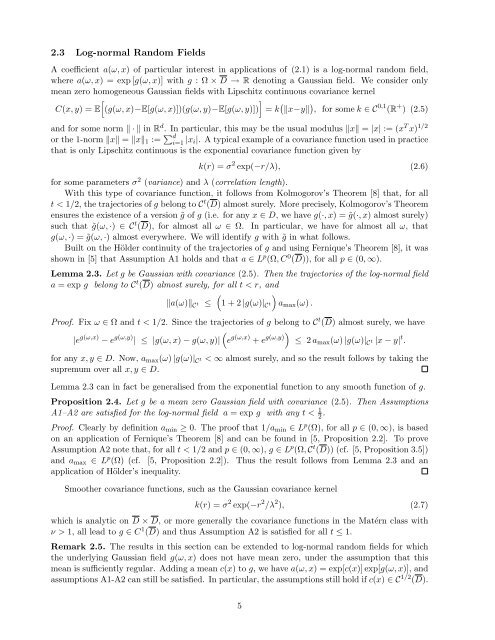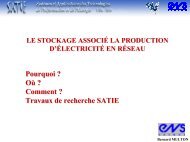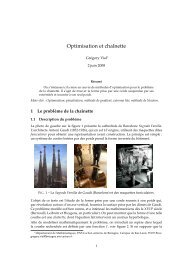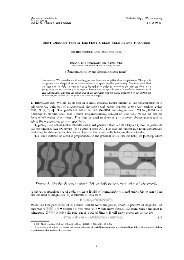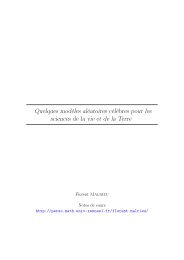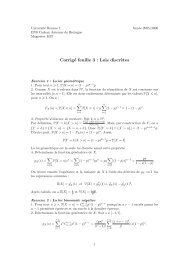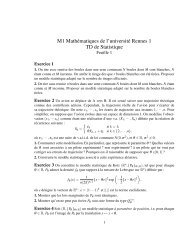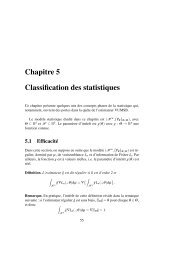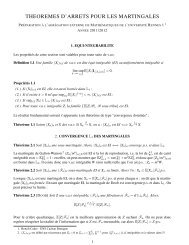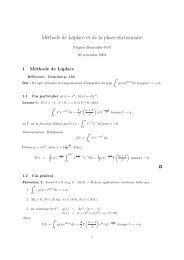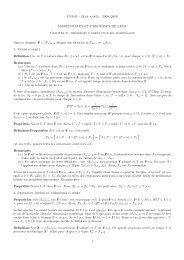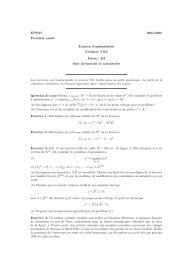Bath Institute For Complex Systems - ENS de Cachan - Antenne de ...
Bath Institute For Complex Systems - ENS de Cachan - Antenne de ...
Bath Institute For Complex Systems - ENS de Cachan - Antenne de ...
Create successful ePaper yourself
Turn your PDF publications into a flip-book with our unique Google optimized e-Paper software.
2.3 Log-normal Random FieldsA coefficient a(ω, x) of particular interest in applications of (2.1) is a log-normal random field,where a(ω, x) = exp [g(ω, x)] with g : Ω × D → R <strong>de</strong>noting a Gaussian field. We consi<strong>de</strong>r onlymean zero homogeneous Gaussian fields with Lipschitz continuous covariance kernel[]C(x, y) = E (g(ω, x)−E[g(ω, x)])(g(ω, y)−E[g(ω, y)]) = k ( ‖x−y‖ ) , for some k ∈ C 0,1 (R + ) (2.5)and for some norm ‖ · ‖ in R d . In particular, this may be the usual modulus ‖x‖ = |x| := (x T x) 1/2or the 1-norm ‖x‖ = ‖x‖ 1 := ∑ di=1 |x i|. A typical example of a covariance function used in practicethat is only Lipschitz continuous is the exponential covariance function given byk(r) = σ 2 exp(−r/λ), (2.6)for some parameters σ 2 (variance) and λ (correlation length).With this type of covariance function, it follows from Kolmogorov’s Theorem [8] that, for allt < 1/2, the trajectories of g belong to C t (D) almost surely. More precisely, Kolmogorov’s Theoremensures the existence of a version ˜g of g (i.e. for any x ∈ D, we have g(·, x) = ˜g(·, x) almost surely)such that ˜g(ω, ·) ∈ C t (D), for almost all ω ∈ Ω. In particular, we have for almost all ω, thatg(ω, ·) = ˜g(ω, ·) almost everywhere. We will i<strong>de</strong>ntify g with ˜g in what follows.Built on the Höl<strong>de</strong>r continuity of the trajectories of g and using Fernique’s Theorem [8], it wasshown in [5] that Assumption A1 holds and that a ∈ L p (Ω, C 0 (D)), for all p ∈ (0, ∞).Lemma 2.3. Let g be Gaussian with covariance (2.5). Then the trajectories of the log-normal fielda = exp g belong to C t (D) almost surely, for all t < r, and()‖a(ω)‖ C t ≤ 1 + 2 |g(ω)| C t a max (ω) .Proof. Fix ω ∈ Ω and t < 1/2. Since the trajectories of g belong to C t (D) almost surely, we have(|e g(ω,x) − e g(ω,y) | ≤ |g(ω, x) − g(ω, y)| e g(ω,x) + e g(ω,y)) ≤ 2 a max (ω) |g(ω)| C t |x − y| t .for any x, y ∈ D. Now, a max (ω) |g(ω)| C t < ∞ almost surely, and so the result follows by taking thesupremum over all x, y ∈ D.Lemma 2.3 can in fact be generalised from the exponential function to any smooth function of g.Proposition 2.4. Let g be a mean zero Gaussian field with covariance (2.5). Then AssumptionsA1–A2 are satisfied for the log-normal field a = exp g with any t < 1 2 .Proof. Clearly by <strong>de</strong>finition a min ≥ 0. The proof that 1/a min ∈ L p (Ω), for all p ∈ (0, ∞), is basedon an application of Fernique’s Theorem [8] and can be found in [5, Proposition 2.2]. To proveAssumption A2 note that, for all t < 1/2 and p ∈ (0, ∞), g ∈ L p (Ω, C t (D)) (cf. [5, Proposition 3.5])and a max ∈ L p (Ω) (cf. [5, Proposition 2.2]). Thus the result follows from Lemma 2.3 and anapplication of Höl<strong>de</strong>r’s inequality.Smoother covariance functions, such as the Gaussian covariance kernelk(r) = σ 2 exp(−r 2 /λ 2 ), (2.7)which is analytic on D × D, or more generally the covariance functions in the Matérn class withν > 1, all lead to g ∈ C 1 (D) and thus Assumption A2 is satisfied for all t ≤ 1.Remark 2.5. The results in this section can be exten<strong>de</strong>d to log-normal random fields for whichthe un<strong>de</strong>rlying Gaussian field g(ω, x) does not have mean zero, un<strong>de</strong>r the assumption that thismean is sufficiently regular. Adding a mean c(x) to g, we have a(ω, x) = exp[c(x)] exp[g(ω, x)], andassumptions A1-A2 can still be satisfied. In particular, the assumptions still hold if c(x) ∈ C 1/2 (D).5


